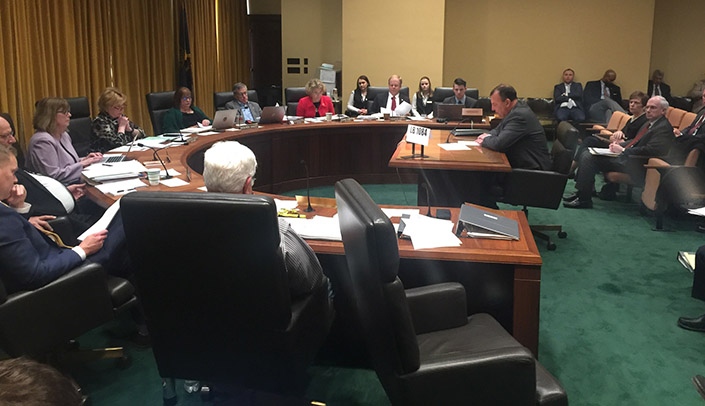Game-changer. Once-in-a-generation opportunity.
That’s how supporters are describing the Nebraska Transformational Project, more commonly referred to as NExT.
On Thursday, campus and community leaders testified in support of LB 1084, which would incentivize the creation of a $2.6 billion project and allow for a significant expansion to UNMC, and its primary clinical partner, Nebraska Medicine. UNMC leaders are seeking $300 million in state support to create a public-private partnership
“The transformational project will be a game-changer for the entire state of Nebraska and the region,” Sen. Mark Kolterman said while introducing the legislation at a Revenue Committee hearing. “I am honored that a majority of my colleagues have joined me by signing on to this bill – an early indication of how this project aligns with our repeated goals and discussions on how we grow this state and create high-skill, high-demand, high-wage jobs.”
UNMC Chancellor Jeffrey P. Gold, M.D., said the project would benefit all Nebraskans by transforming the access to and the quality of health education, training, research and care. NExT also “represents a once-in-a-generation chance for Nebraska to cement its status as a partner with four key departments of the federal government,” he said.
The medical center has a strong track record of success with public-private partnerships, Dr. Gold said. He specifically cited the Fred & Pamela Buffett Cancer Center, which has exceeded all expectations and yielded both a medical and impressive economic impact of $246.8 million in 2018, the center’s second year of operations. In addition, he said, that project created employment for 2,334 Nebraskans and produced over $8.5 million in the last year alone in state and local tax revenue. The state of Nebraska contributed $50 million to that project.
NExT would have an even bigger impact, he said, and state support would be used to leverage federal, private and philanthropic investment, which would be dedicated to clinical space and infrastructure.
The NExT project includes two major components:
- A state-of-the-art academic medical center facility that serves the needs of Nebraska and transforms the quality and practice of health education, training, research and care. The facility would provide capacity for training more health professional students.
- A federal all-hazard disaster response military and civilian partnership that provides training in the management of highly infectious and other emerging threats, as well as critical care, for federal, civilian and military personnel.
Leslie Andersen, president and CEO of the Bank of Bennington, testified on behalf of the Omaha Chamber and in support of the NExT project. “We know this type of public-private partnership works,” she said, also noting the success of the cancer center. “And we know that it works well at the med center.At the bank of Bennington, we get to see firsthand the impact a construction project can have on a community, but the NExT project is on a scale that none of us have ever seen. Without question, this project will have a profound impact on our community and its effects will trickle down to community businesses and customers that I work with every day.”
What stands out, Andersen said, is the size of the investment and the number of jobs that it will create. “Jobs are the lifeblood of our communities . . .and essential for the well-being of the state,” she said.
Based on a preliminary estimate of this $2.6 billion public-private investment, a Tripp Umbach study conservatively reports that the NExT initiative will:
- Create a total economic impact of $7.6 billion during construction of the project, over the next decade.
- Generate employment directly and indirectly for 41,655 Nebraska workers over the next decade. This includes nearly 33,000 construction-related jobs and 8,700 permanent jobs.
- Generate an estimated $211.8 million in state tax revenue over that 10-year period. This would be in addition to local government tax revenue.
- Adding an additional $1.3 billion annually to the state economy when the project is fully operational in 2030, conservatively generating $38.2 million in annual state tax revenue.
If this bill is of interest, university employees and students may consider reaching out to state senators but must contact them on their own time and without using university resources (computers, telephones, letterhead or university accounts).
